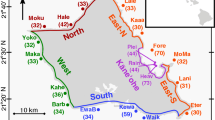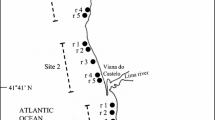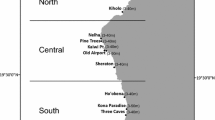Abstract
A 9-year study of the structure of assemblages of fish on 20 coral patch reefs, based on 20 non-manipulative censuses, revealed a total of 141 species from 34 families, although 40 species accounted for over 95% of sightings of fish. The average patch reef was 8.5 m2 in surface area, and supported 125 fish of 20 species at a census. All reefs showed at least a two-fold variation among censuses in total numbers of fish present, and 12 showed ten-fold variations. There was also substantial variation in the composition and relative abundances of species present on each patch reef, such that censuses of a single patch reef were on average about 50% different from each other in percent similarity of species composition (Czekanowski's index). Species differed substantially in the degree to which their numbers varied from census to census, and in the degree to which their dispersion among patch reefs was modified from census to census. We characterize the 40 most common species with respect to these attributes. The variations in assemblage structure cannot be attributed to responses of fish to a changing physical structure of patch reefs, nor to the comings and goings of numerous rare species. Our results support and extend earlier reports on this study, which have stressed the lack of persistant structure for assemblages on these patch reefs. While reef fishes clearly have microhabitat preferences which are expressed at settlement, the variations in microhabitat offered by the patch reefs are insufficient to segregate many species of fish by patch reef. Instead, at the scale of single patch reefs, and, to a degree, at the larger scale of the 20 patch reefs, most of the 141 species of fish are distributed without regard to differences in habitat structure among reefs, and patterns of distribution change over time. Implications for general understanding of assemblage dynamics for fish over more extensive patches of reef habitat are considered.
Similar content being viewed by others
References
Bohnsack JA (1983) Species turnover and the order versus chaos controversy concerning reef fish community structure. Coral Reefs 1: 223–228
Brothers EB, Williams DMcB, Sale PF (1983) Length of larval life in twelve families of fishes at “One Tree Lagoon”, Great barrier Reef, Australia. Mar Biol 76: 319–324
Caffey HM (1985) Spatial and temporal variation in settlement and recruitment of intertidal barnacles, Ecol Monogr 55: 313–332
Chesson PL (1986) Environmental variation and the coexistence of species. In: Diamond J, Case TJ (eds) Community ecology. Harper and Row, New York, pp 240–256
Cody ML (1974) Competition and the structure of bird communities. Princeton University Press, Princeton
Colwell RK, Futuyma DJ (1971) On the measurement of niche breadth and overlap. Ecology 52: 567–576
Connell IH (1978) Diversity in tropical rain forests and coral reefs. Science 199: 1302–1310
Connor EF, Simberloff DS (1979) The assembly of species communities: chance or competition?. Ecology 60: 1132–1140
Connor EF, Simberloff DS (1986) Competition, scientific method, and null models in ecology. Am Sci 74: 155–162
Dayton PK (1971) Competition, disturbance, and community or ganization: the provision and subsequent utilization of space in a rocky intertidal community. Ecol Monogr 41: 351–389
Diamond JM (1975) Assembly of species community. In: Cody ML, Diamond JM (eds) Ecology and evolution of communities. Harvard University Press, Cambridge, pp 342–444
Doherty PJ, Williams DMcB (1988) The replenishment of coral reef fish populations. Oceanogr Mar Biol Annu Rev 26: 487–551
Douglas WA (1982) The feeding biology of cardinalfishes (Pisces: Apogonidae) at One Tree Reef. MS thesis, University of Sydney
Drake JA (1990) Communities as assembled structures: do rules govern patterns?. Trends Ecol Evol 5: 159–164
Eckert GJ (1984) Annual and spatial variation in recruitment of labroid fishes among seven reefs in the Capricorn/Bunker Group. Great Barrier Reef. Mar Biol 78: 123–127
Feinsinger P, Spears EE, Poole RW (1981) A simple measure of niche breadth. Ecology 62: 27–32
Fowler AJ (1990) Spatial and temporal patterns of distribution and abundance of chaetodontid fishes at One Tree Reef, southern GBR. Mar Ecol Prog Ser 64: 39–53
Fowler AJ, Doherty PJ, Williams DMcB (1992) Multi-scale analysis of recruitment of a coral reef fish on the Great Barrier Reef. Mar Ecol Prog Ser 82: 131–141
Gladfelter WB, Ogden JC, Gladfelter EH (1980) Similarity and diversity among coral reef fish communities: a comparison between tropical western Atlantic (Virgin Islands) and tropical central Pacific (Marshall Islands) patch reefs. Ecology 61: 1156–1168
Grant BR, Grant PP (1982) Niche shifts and competition in Darwin's finches: Geospiza conirostris and congeners. Evolution 36: 637–657
Jones GP (1991) Postrecruitment processes in the ecology of coral reef fish populations: a multifactorial perspective. In: Sale PF (ed) The ecology of fishes on coral reefs. Academic Press, San Diego, pp 294–328
Kareiva PM (1987) Habitat fragmentation and the stability of predator-prey interactions. Nature 321: 388–391
Kohn AJ, Riggs AC (1982) Sample size dependence in measures of proportional similarity. Mar Ecol Prog Ser 9: 147–151
Leis JM (1991) The pelagic stage of reef fishes: the larval biology of coral reef fishes. In: Sale PF (ed) The ecology of fishes on coral reefs. Academic Press, San Diego, pp 183–230
Levin SA (1992) The problem of pattern and scale in ecology. Ecology 73: 1943–1967
Luckhurst BE, Luckhurst K (1978) Analysis of the influence of the substrate variables on coral reef fish communities. Mar Biol 49: 317–323
Ludington CA (1979) Tidal modifications and associated circulation in a platform reef lagoon. Aust J Mar Freshwater Res 30: 425–430
Mapstone BD (1988) The determination of patterns in the abundance of Pomacentrus molluccensis Bleeker on the southern Great Barrier Reef. PhD disseration, University of Sydney
Paine RT, Levin SA (1981) Intertidal landscapes: disturbance and the dynamics of pattern. Ecol Monogr 51: 145–198
Pitcher CR (1988a) Validation of a technique for reconstructing daily patterns in the recruitment of coral reef damselfish. Coral Reefs 7: 105–111
Pitcher CR (1988b) Spatial variation in the temporal pattern of recruitment of a coral reef damselfish, Proc Sixth Internat Coral Reef Symp 2: 811–816
Price PW (1984) Alternative paradigms in community ecology. In: Price PW, Gaud WS, Slobodchikoff CN (eds) A new ecology. Wiley, New York, pp 353–383
Risk MJ (1972) Fish diversity on a coral reef in the Virgin Islands. Atoll Res Bull 153: 1–6
Robertson DR (1973) Field observations on the reproductive behavior of a pomacentrid fish, Acanthochromis polyacanthus. Z Tierpsychol 32: 319–324
Robertson DR (1988 a) Abundances of surgeonfishes on patchreefs in Caribbean Panama: due to settlement, or post0settlement events? Mar Biol 97: 495–501
Robertson DR (1988 b) Extreme variation in settlement of the Caribbean triggerfish Balistes vetula in Panama. Copeia 1988: 698–703
Roughgarden J (1989) The structure and assembly of communities. In: Roughgarden J, May RM, Levin SA (eds) Perspectives in ecological theory. Princeton University Press, Princeton, pp 203–226
Roughgarden J, Iwasa Y, Baxter C (1985) Demographic theory for an open marine population with space-limited recruitment. Ecology 66: 54–67
Roughgarden J, Gaines S, Possingham H (1988) Recruitment dynamics in complex life cycles. Science 241: 1460–1466
Sale PF (1980 a) The ecology of fishes on coral reefs. Oceanogr Mar Biol Annu Rev 18: 367–421
Sale PF (1980 b) Assemblages of fish on patch reefs-predictable or unpredictable? Environ Biol Fish 5: 243–249
Sale PF (1988) Patterns of recruitment in coral reef fishes. Proc Fifth Internat Coral Reef Congr 5: 391–396
Sale PF (1988) Perception, pattern, chance and the structure of reef fish communities. Environ Biol Fish 21: 3–15
Sale PF (1990) Recruitment of marine species: is the bandwagon rolling in the right direction? Trends Ecol Evol 5: 25–27
Sale PF (1991) Reef fish communities: open nonequilibrial systems. In: Sale PF (ed) The ecology of fishes on coral reefs. Academic Press, San Diego, pp 564–598
Sale PF, Douglas WA (1981) Precision and accuracy of visual census technique for fish assemblages on coral patch reefs. Environ Biol Fish 6: 333–339
Sale PF, Douglas WA (1984) Temporal variability in the community structure of fish on coral patch reefs, and the relation of community structure to reef structure. Ecology 65: 409–422
Sale PF, Ferrell DJ (1988) Early survivorship of juvenile coral reef fishes. Coral Reefs 7: 117–124
Sale PF, Guy JA (1992) Persistence of community structure: what happens when you change taxonomic scale? Coral Reefs 11: 147–154
Sale PF, Steel WJ (1989) Random placement and the structure of reef fish communities Mar Ecol Prog Ser 28: 165–174
Sale PF, Steel WJ (1989) Temporal variability in patterns of association among fish species on coral patch reefs. Mar Ecol Prog Ser 51: 35–47
Sale PF, Doherty PJ, Eckert GJ, Douglas WA, Ferrell DJ (1984) Large scale spatial and temporal variation in recruitment to fish populations on coral reefs. Oecologia 64: 191–198
Sale PF, Eckert GJ, Ferrell DJ, Fowler AJ, Jones TA, Mapstone BD, Steel WJ (1986) Demography of selected aquarium fishes and implications for the management of their collection. Final Report to the Great Barrier Reef Marine Park Authority, Townsville, Australia (unpublished)
Schoener TW (1968) The Anolis lizards of Bimini: resource partitioning in a complex fauna. Ecology 49: 704–726
Schroeder RE (1985) Recruitment rate patterns of coral-reef fishes at Midway Lagoon (northwestern Hawaiian Islands). Proc Fifth Internat Coral Reef Congr 5: 379–384
Sousa WP (1979) Experimental investigations of disturbance and ecological succession in a rocky intertidal algal community. Ecol Monogr 49: 227–254
Sousa WP (1981) Disturbance in marine intertidal boulder fields: the nonequilibrium maintenance of species diversity. Ecology 60: 1225–1239
Sousa WP (1984) Intertidal mosaics: patch size, propagule availability, and spatially variable patterns of succession. Ecology 65: 1918–1935
Thresher RE (1983) Habitat effects on reproductive success in the coral reef fish, Acanthochromis polyacanthus (Pomacentridae). Ecology 64: 1184–1199
Thresher RE (1985) Distribution, abundance, and reproductive success in the coral reef fish, Acanthochromis polyacanthus. Ecology 66: 1139–1150
Victor BC (1982) Daily otolith increments and recruitment in two coral-reef wrasses, Thalassoma bifasciatum and Halichoeres bivittatus. Mar Biol 71: 203–208
Victor BC (1983) Recruitment and population dynamics of a coral reef fish. Science 219: 419–420
Victor BC (1986a) Larval settlement and juvenile mortality in a recruitment-limited coral reef fish population. Ecol Monogr 56: 145–160
Victor BC (1986b) Duration of the planktonic larval stage of one hundred species of Pacific and Atlantic wrasses (family Labridae). Mar Biol 90: 317–326
Warner RR, Hughes TP (1988) The population dynamics of reef fishes. Proc Sixth Internat Coral Reef Symp 1: 149–155
Warner RR, Robertson DR (1978) Sexual patterns in the labroid fishes of the western Caribbean. I. The wrasses (Labridae). Smithson Contrib Zool 254: 1–27
Werner EE, Gilliam JF (1984) The ontogenetic niche and species interactions in size-structured populations. Annu Rev Ecol Syst 15: 393–425
Werner EE, Hall DJ (1977) Competition and habitat shift in two sunfishes (Centrarchidae). Ecology 58: 869–876
Whittaker RH (1975) Communities and ecosystems, 2nd edn. MacMillan, New York
Wiens JA (1989) Spatial scaling in ecology. Funct Ecol 3: 385–397
Wiens JA, Rotenberry JT (1981) Habitat associations and community structure of birds in shrubsteppe environments. Ecol Monogr 51: 21–41
Williams DMcB, Sale PF (1981) Spatial and temporal patterns of recruitment of juvenile coral reef fishes to coral habitats within “One Tree Lagoon”, Great Barrier Reef. Mar Biol 65: 245–253
Wolda H (1981) Similarity indices, sample size and diversity. Oecologia 50: 296–302
Zar JH (1984) Biostatistical analysis, 2nd edn. Prentice-Hall, New Jersey
Author information
Authors and Affiliations
Rights and permissions
About this article
Cite this article
Sale, P.F., Guy, J.A. & Steel, W.J. Ecological structure of assemblages of coral reef fishes on isolated patch reefs. Oecologia 98, 83–99 (1994). https://doi.org/10.1007/BF00326094
Received:
Accepted:
Issue Date:
DOI: https://doi.org/10.1007/BF00326094




